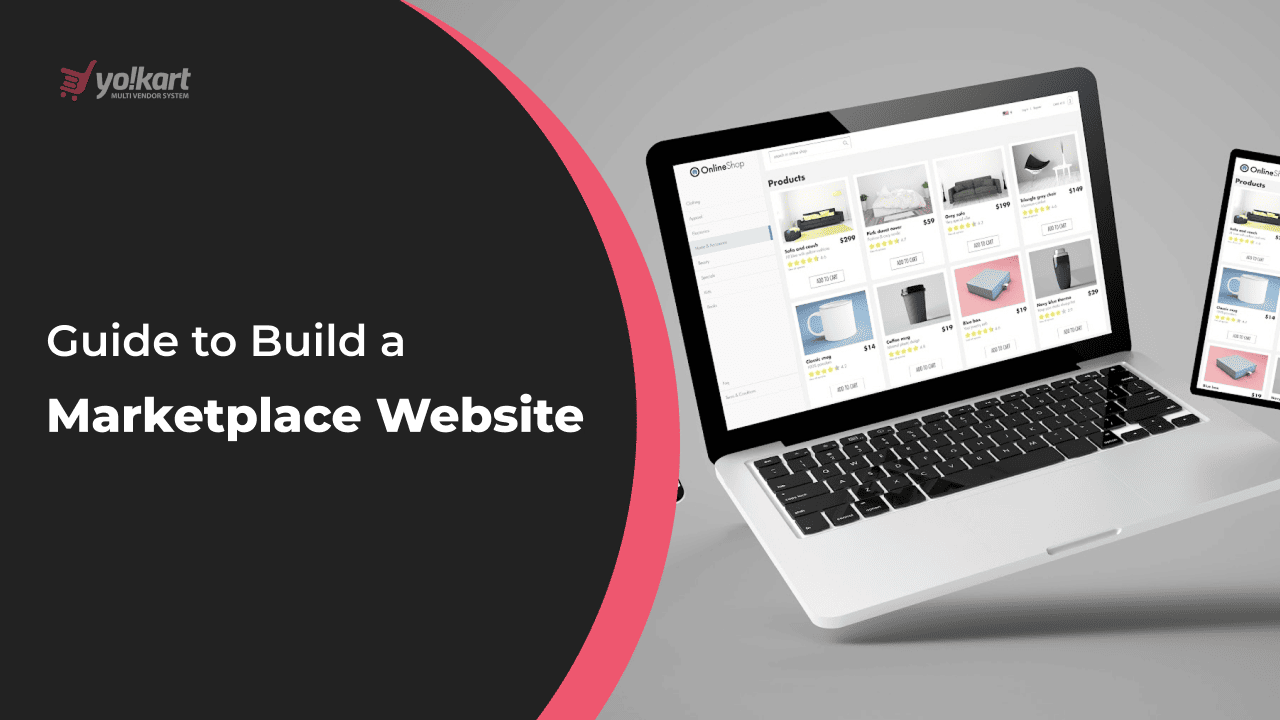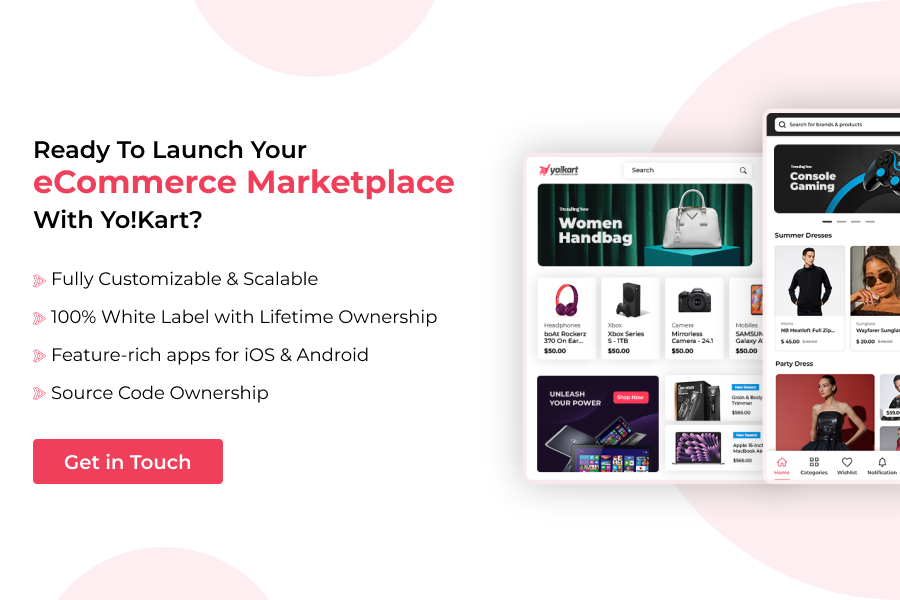Planning to launch a marketplace website but wondering where to start? Don’t worry, in this informative blog you will get to know about:
- What is a marketplace website?
- What are the advantages of launching a marketplace website?
- How to launch a marketplace website?
- What is the best approach for launching a marketplace website?
The eCommerce industry is growing rapidly. There are countless businesses that are moving online from traditional marketplaces. However, this online shift is about more than just selling products online. It’s an opportunity for businesses to reach a global audience base. A marketplace website breaks all the barriers and allows businesses to trade with the global market.
If you are also one of the entrepreneurs and business owners who want to profit from this online shift, you can build a marketplace website. Yet, before you dive deep into the blog, let’s take a look at the number of eCommerce. This will help you figure out the potential of this ever-evolving industry.
According to Statista, the estimated retail e-commerce sale was $5.8 trillion in 2023 and will surpass $6 trillion in 2024. Also, the prediction says that retail sales will reach a new height of $8+ trillion by 2028 to set a new benchmark.
The above-estimated numbers indicate that the industry is having huge growth potential and one can reap its benefits by building an eCommerce marketplace website.
Table Of Contents
- What is a Marketplace Website?
- What are the Types of Marketplace Websites?
- Key Benefits of Building a Marketplace Website
- Marketplace Trends: Tips to Maintain Competitiveness in the eCommerce Landscape
- 7 Essential Steps to Launch a Marketplace Website
- Why Launch Your Marketplace Website with Yo!Kart?
- 10 Essential Features of Yo!Kart for Your Marketplace Website
- Final Thought
- FAQs
What is a Marketplace Website?
A marketplace website is like a traditional marketplace where buyers and sellers meet to exchange goods and services. However, apart from connecting sellers with buyers, there are a lot of differences that set a marketplace website apart from a traditional marketplace.
The primary difference that makes a marketplace website completely different from a traditional marketplace is. A Traditional marketplace is a physical store often located in the center of the city with limited customer coverage. On the other hand, a marketplace website is a virtual store located on a server with global customer access. It connects buyers with sellers on a virtual storefront. The marketplace website has no boundary of geographical locations, unlike traditional marketplaces.
A marketplace website helps businesses to reach a wider audience base. Businesses can target global markets with the help of their online marketplaces. At online marketplaces, buyers can browse products, get detailed information shared, make online purchases, initiate payments at their convenience through multiple payment methods, track their placed orders and get the items at their doorsteps with the help of marketplace website delivery partners.
Today, a large number of the global population is attracted towards online shopping [ping and making purchases online. In number, out of the 8 billion the global population, 2.7 billion people are shopping online to meet their buying needs. This online shift is drawing businesses to build online marketplace websites.
What are the Types of Marketplace Websites?
Types of marketplace websites may vary depending on their business segments, target audiences and offerings. Below are the different types of marketplace websites:
Marketplace Types Based on Business Model
A marketplace can be of two types vertical and Horizontal by business model.
- Vertical marketplace: A marketplace that primarily focuses on a single niche to target audience with specific requirements.
Example: Etsy – Focuses on a single niche.
- Horizontal Marketplace: These marketplaces focus on multiple niches that cover diverse audience bases.
Example: Poshmark – Focuses on multiple niches.
Marketplace Types Based on Target Audience
According to the target audience, marketplace websites can be divided into four main categories. Below mentioned marketplaces are the primary types of marketplace websites
- B2C (Business to Customer): In this type of marketplace website, businesses offer products or services to customers. Amazon, eBay, Walmart and Flipkart are among the popular examples of B2C websites.
- B2B (Business to Business): B2B marketplace websites directly sell products to the business in bulk quantity. This marketplace facilitates opportunities for businesses to trade with another businesses. Alibaba, Ali Express and Amazon Business are well-known B2B marketplaces worldwide.
- C2C (Customer to Customer): Etsy, Poshmark and Depop are the marketplace leaders in the C2C marketplace segments. The C2C marketplace provides the opportunity for customers to reach out to other customers in order to buy or sell their products. In such a marketplace buyer can himself be a seller or the seller can be a buyer means vice-versa.
- D2C (Direct to Customer): This marketplace type is also gaining popularity these days. In the D2C marketplace model, businesses directly reach out to the customers. It helps brands to establish good connections with their customers by offering a better understanding of customer’s preferences. Nike, Warby Parker, Casper and Lenskart are a few popular examples of D2C marketplaces.
Marketplace Types Based on Offering
Apart from the above-discussed marketplace types, you can also consider marketplaces based on their offering:
- Product-based Marketplace: A product-based marketplace offers physical or virtual products that can be ordered or downloaded.
- Service-based Marketplace: These marketplaces offer different types of professional services through their platforms.
Key Benefits of Building a Marketplace Website
Building and launching a marketplace website is a great idea. If you are also one of the entrepreneurs who has decided to build a marketplace website. You should go through the below key benefits of building a marketplace website. These benefits will surely help you boost your confidence. Let’s explore the benefits below:
- Access to a Wide Audience Base: A marketplace website gives you the opportunity to access a wide audience. It breaks the geographical barriers allowing the marketplace to reach out to a global customer base.
Let’s understand it through an example. Suppose, you have an offline store in your locality or city. To whom max you can reach out? You can only reach out to customers from your locality or can get some occasional new visitors.
On the other hand, you have a marketplace website. Now, you have no geographical limitations, you can expand your reach worldwide. That means as much as you want it to be expanded. An online marketplace helps businesses attract millions of visitors across the world daily.
- Flexibility to Scale and Grow: The marketplace website gives you the flexibility to scale and grow your business. There is no limitation on space and storage. You can scale your platform with your business’s growing needs.
In addition to this, you have the flexibility to add or remove features and functionalities to the marketplace as per the requirements. No matter how many visitors are visiting your platform daily or how many orders are placed, you can increase the marketplace efficiency to fit your business’s requirements.
- Diverse Revenue Generation Streams: Marketplace websites allow marketplace owners to generate revenue from multiple sources. Unlike a conventional marketplace where limited revenue channels, a marketplace website has diverse revenue streams. An online marketplace owner can generate revenue through:
| Revenue Stream | Services |
| Product Listing Fees | In this revenue model, the marketplace charges a certain amount for listing products on the platform. |
Commission on each sale | This monetization method is one of the most popular revenue streams where marketplaces charge a commission percentage from the sellers on each sale made. |
Subscription plans | The subscription revenue model is also gaining popularity these days. In this monetization model, the marketplace charges a subscription fee from the buyers or sellers to offer them premium services like free shipping, quick delivery, unlimited listings, access to advanced tools, promotional opportunities and more. |
Advertising | Marketplaces allow sellers to promote their products for more visibility and search results by paying a certain amount to the marketplace. In addition, a marketplace also earns through third-party advertisement which allows advertisers to run ad campaigns on the platform. |
In addition, revenue streams can be more. However, you have to choose those that apply to your marketplace idea.
- Streamlined Operations: By building a marketplace website you can manage all your marketplace operations efficiently. It streamlines and automates all the operations on the platform. From inventory management to shipping management, customer services to reports and analytics, and so on. The advanced features and functionalities allow businesses to operate and control the platform with no hassle.
Build Your Own eCommerce Marketplace Platform
Marketplace Trends: Tips to Maintain Competitiveness in the eCommerce Landscape
Following trends are as important as building a marketplace. Businesses that follow trends are never left behind. If you are also going to launch your marketplace website, these trends will let you take a competitive advantage. These key marketplace trends will help you be ahead of the competition. Let’s explore the marketplace trends below:
- Personalized Recommendations: Have you ever wondered how marketplaces like Amazon, eBay, or Flipkart mostly showcase relevant products that you might need or want to buy?
Today, marketplaces are analyzing buyer’s history, behavior, interests and much more to recommend relevant products to the customer at a personal level. These recommendations are not just increasing conversion rates but are also helping businesses gain loyal customers on the platform.
Furthermore, it also helps the marketplace to retain their customers and increase customer visits. According to a report, customers prefer to visit platforms that offer relevant products they are interested in. Therefore, personalization in your marketplace website can help increase conversion rate and let you lead the industry.
- Augmented Reality: Augmented reality is going to play a crucial role in boosting the overall shopping experience for customers in the years ahead. Most businesses are implementing this revolutionary technology in their marketplace.
Augmented reality offers an immersive shopping experience to customers by allowing them to see virtual products in the real world. Customers can visualize products using AR technology in their space and decide whether a product will fit in the space or not.
This feature will not just help customers get an overview of the products but will also increase satisfaction levels and decrease returns which can indirectly contribute to revenue generation.
- Social Commerce: Social commerce means getting an opportunity to interact with a large pool of customers who are actively using social media through ad campaigns, influencers and creating the brand page or social account.
However, you can also get more visitors on the platform by giving access to social media users to log in to the marketplace using their social accounts through social media integration. It allows customers quick and easy registration on the platform using their social accounts such as Facebook, Instagram, Twitter, Google or any other.
- Mobile Friendly Solution: The rise in mobile commerce revenue is grabbing attention. Businesses are readily working to improve their marketplace websites by making them mobile-friendly and also launching mobile apps.
According to the report, mobile devices were responsible for 60% of total eCommerce sales in 2023 and the percentage is increasing constantly. It shows how people are interested in making their online purchases using their mobile phones.
Therefore, making a mobile-friendly marketplace solution will give you a competitive advantage. It will help your business improve its conversion rate. You can also launch a marketplace mobile app. Especially for buyers on the platform in order to provide convenience in their shopping.
- Sustainable Shopping Experience: Sustainability is now becoming popular among customers and businesses. They have started following sustainable practices.
On the one hand, where businesses are implementing sustainable practices such as utilization of biodegradable packaging materials, eco-friendly shipping and more. On the other hand, the buyers are also encouraging those brands who are contributing towards saving the environment through their nature-friendly approaches. They are most likely to buy and follow brands with such an initiative for the preservation of the environment.
So, according to the demand of the era and to contribute towards nature, you can also work on sustainability to bring value to your business.
You can also Explore Trends You Can’t Ignore When Starting a Marketplace in 2025
7 Essential Steps to Launch a Marketplace Website
Now, you have reached the core part where you will be learning steps that need to be considered before you launch your marketplace website. No matter, whether you are launching a new marketplace website or expanding your existing one, these steps will help you explore the key considerations to a marketplace website with higher success chances:
1. Identify Marketplace Idea
Before you begin with the development of a marketplace website, the first and foremost step is to identify the idea behind building your marketplace website. While identifying your marketplace idea, you can focus on solving real problems, target a niche that is not targeted yet, or you can go with the industry with huge potential and more.
Your marketplace idea ensures the level of success and will further help you decide to craft a tailored solution while developing your marketplace website.
However, once you identified and finalized your marketplace idea, it doesn’t mean you should directly start with the development process. There is a lot more to do, analyze, explore and understand. Let’s understand the below steps carefully.
2. Do Market Research
In the next step, after finalizing the marketplace idea, you have to conduct proper market research. A thorough market research may include analyzing competitors, finding gaps, identifying customer needs, recognizing pain points and more.
However, this research will not just help you gain insights but will also let you validate your marketplace idea.
In addition, while doing market research don’t forget to discuss your marketplace idea with multiple experts and common people as well. They will help you get feedback and make you understand the pros and cons that you might be missing or haven’t recognized yet. This feedback will help you reshape your marketplace idea and plan strategies accordingly.
3. Define Value Proposition
Again this is a significant step in building a marketplace website. It helps businesses set them apart from others. A unique Value Proposition makes your business unique and attracts more visitors to the platform.
UVP simply means, what additional or different you are offering on your marketplace platform that others are not providing.
Taking an example, you will find Etsy with one of the well-defining unique value propositions. Etsy recognized independent artisans and craftsmen and connected them with customers who are looking for unique, handmade and vintage items.
As you can see, Etsy tackled one of those niches that others were not embarked on and this made Etsy one of the most popular and successful marketplaces.
Therefore, if you want to see your marketplace reaching new heights and achieving success, you have to be well-defined with your value proposition.
4. Choose Revenue Model
Once you have done with your marketplace idea, research and unique value proposition, the next step is to decide your revenue model. The ultimate goal of any business.
It is one of the most relevant business decisions that marketplace owners need to take before launching a marketplace website.
However, while deciding revenue streams, marketplace owners should be very careful. It decides the future and will help you run and operate your marketplace.
There are countless instances where businesses make mistakes in deciding revenue models that lead to the biggest drawback or marketplace failure.
Therefore, your monetization model should be properly and strategically planned. There are several considerations that need to be considered such as your marketplace type, target audience, product or service type, competition and more before you decide your marketplace revenue model.
Here are some popular revenue models that marketplaces follow to generate revenue from:
- Commission-based Revenue Models
- Product Listing-Based Revenue Model
- Subscription-Based Revenue Models
- Advertising and Sponsored Ad-based Revenue Model
Always choose revenue models that best suit your marketplace website.
5. Build a Marketplace MVP
Building an MVP ( minimum Viable Product) is a strategic move. It works as a test version of your marketplace that comes with essential features and functionalities.
Entrepreneurs and businesses launch MVPs before they launch a full-fledged marketplace platform in the initial stages. It helps them validate their business idea.
However, you can launch your Marketplace MVP with minimum spending. Moreover, it doesn’t require much time, resources and anything else to launch. You can introduce your marketplace MVP faster compared to building a platform from scratch. It takes less time to launch compared to the final product.
In short, launching an MVP means testing your marketplace idea with less risk. In addition, if you find your idea successful, MVP itself gives you the flexibility to scale your platform according to your further marketplace needs.
6. Reach out to Sellers and Buyers
The next step is to attract sellers and buyers to your platform. Because the profit of a marketplace depends on the number of sellers and buyers on the platform. They are the pillars of supply and demand on the platform, both attract each other on the platform.
Let’s make the supply and demand concept more clear for you. Suppliers supply products where demands are high, and buyers demand where supplies are constant.
Simply, both sellers and buyers are interconnected to each other. Without sellers and buyers, a marketplace means nothing and has nothing to do.
However, attracting sellers and buyers on the platform is not just launching a marketplace but you have to plan strategies to attract them. You can run ad campaigns on multiple sources with the most relevant users, approach social media, conduct press releases, and more.
7. Launch Fully Functional Platform and Grow
Once you are finalized and satisfied with your marketplace MVP, now, it’s time to launch your full-fledged eCommerce marketplace website. You can go live with the audience and start your marketplace promotion through various platforms and sources using diverse marketing tools and strategies.
In the initial stages, don’t just focus on revenue generation. It is an automated process, once you have streamlined marketplace operations, things will automatically come your way.
In addition, feedback and updates are crucial contributing factors to decide the marketplace’s future. Always keep in mind that customer feedback and continuous updates help businesses to maintain competitiveness.
Reviews are one of the most useful tools for the marketplace to monitor buyers, sellers and products on the platform. Reviews not only provide feedback but help you prepare your strategies and plan of action. Moreover, it helps marketplace owners grow their platforms.
Launch Your Marketplace Website with Yo!Kart
Why Launch Your Marketplace Website with Yo!Kart?
Yo!Kart is a readymade eCommerce marketplace solution. It helps entrepreneurs and businesses to launch their marketplaces efficiently. Yo!Kart is a fully customizable and scalable solution that can meet all your unique business requirements. In addition, it is also a self-hosted marketplace solution that allows you to host the platform on your preferred server.
Launching your marketplace website with Yo!Kart can give your business a quick start. You can introduce your platform faster into the market.
Moreover, Yo!Kart is an affordable option for the business that allows them to launch their marketplace website starting at $499. By launching your platform with Yo!Kart, you can overcome the hassle of developing your marketplace website from scratch.
10 Essential Features of Yo!Kart for Your Marketplace Website
As a ready-to-use marketplace solution, Yo!Kart comes with all the essential features and functionalities. It allows you to launch and operate your platform effectively. Let’s explore 10 essential features for your marketplace website that come with Yo!Kart:
- Easy Registration: Yo!Kart’s easy registration steps allow sellers and buyers to register on the platform easily.
- Admin Dashboard: Yo!Kart has a robust admin dashboard that helps the admin to monitor, analyze, control and grow the marketplace.
- Seller Dashboard: The featured seller dashboard of Yo!Kart allows sellers to manage their listings, inventory and sales more efficiently.
- Buyer Dashboard: Yo!Kart’s buyer Dashboard is entirely user-friendly and allows buyers to manage their profiles, track orders, view transactions and more.
- Product Page: The detailed product page allows buyers to easily navigate and get the details of the products.
- Search and filter: The advanced search and filter options allow buyers to search and filter recommended products from a wide range of products.
- Add to Cart: Yo!Kart has an add-to-cart feature that allows buyers to add products to their cart and make purchases as per their preferences.
- Easy Checkout: The checkout page is designed in such a way that helps buyers complete checkout without any hassle.
- Multiple Payment Gateways: Yo!Kart has 20+ payment gateways that help businesses enable the most preferred gateways according to geographical needs.
- Order Tracking: This feature helps buyers get the details of the product once they are shipped to their delivery locations.
Apart from the above-mentioned features, Yo!Kart has several more features including user levels for admin, sellers and buyers that can be explored by browsing our instant product demos or booking a detailed product demo with our experts.
Our Clientele: Making Yo!Kart more Reliable Selection to Launch a Marketplace?
Yo!Kart has empowered 5K+ businesses worldwide by allowing them to build and launch their own eCommerce marketplace platforms from different niches. Let’s explore our clientele across the world:
- Upcoming Store: A fashion marketplace from Australia sells clothing, beauty products and accessories for men, women and kids on the platform.
- Voyij: A marketplace platform launched with Yo!Kart for travelers and shoppers that allows them to buy products from local businesses of Alaskan on vacation.
- NPK Marketplace: A US-based sustainable marketplace platform that offers natural, NPK-certified, climate-smart products such as natural fertilizer.
- Anyflexo: A leading B2B marketplace from Estonia, also launched with Yo!Kart. Anyflexo offers flexographic printing products and other materials for cleaning, postpress, prepress and printing.
- Mastang: Launched with Yo!Kart, Mastang is a popular UK-based multi-product marketplace known for selling sports items, home and garden accessories, electronics, books and more.
Let’s explore our wide pool of global clientele: Marketplaces Launches with Yo!Kart
Final Thought
In this informative article, you went through all the details on how to launch a marketplace website including what is a marketplace website, types of marketplaces, key benefits of building a marketplace, marketplace trends to follow to maintain competitiveness, steps to follow or consider before launch, and more.
In addition, you have also explored the benefits of launching a marketplace website with Yo!Kart including its key features.
Therefore, if you are an entrepreneur and business owner who wants to build and launch a marketplace website with minimum spending, Yo!Kart can be the most trusted and reliable marketplace solution for you.
FAQs
Q 1. Do I need to have technical expertise to manage a marketplace website?
Ans. Alright, if you are building a marketplace from scratch or choosing a complex marketplace solution, you might need technical knowledge to manage and operate your marketplace.
On the other hand, if you are selecting Yo!Kart as your readymade marketplace solution, you don’t need technical expertise. A common individual with no coding knowledge can operate and manage the platform.
Q 2. What is the cost of developing a marketplace website?
Ans. Initially, building a marketplace website can cost up to $200000. However,
the cost of developing a marketplace website can vary depending on factors including the complexity of the marketplace website, features and functionalities required, number of tools, plugins and much more.
With Yo!Kart you can launch your marketplace website with a minimum cost starting at $499.
Q 3. How long does it take to build a marketplace website?
Ans. Building a marketplace website from scratch may take 6 months to 8 months or even more.
With Yo!Kart, it is possible to launch your marketplace website within 3 working days. However, the timeline may vary depending on your marketplace customization requirements.
Q 4. Which is the trusted readymade marketplace solution?
Ans. There are numerous marketplace solutions available in the market and Yo!Kart is one of the reliable ones. Yo!Kart has empowered 5000+ businesses across the world. If you are looking for the most trusted readymade marketplace solution then launch your marketplace website with Yo!Kart.
Q 5. Is Yo!Kart a mobile responsive software solution?
Ans. Yes, Yo!kart is a mobile responsive software solution that allows buyers to make purchases using mobile or any such devices easily.
In addition, Yo!Kart has mobile applications for Android and iOS smartphone users.




